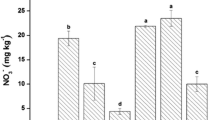Abstract
The contamination of soils with heavy metals is a growing concern in modern societies. To avoid the spread of contamination, soil stabilization techniques can be applied mixing materials with the soil in order to partially immobilize heavy metals. Carbon nanotubes (CNTs) are nanomaterials known for its exceptional properties, like high surface area and adsorption capacity. Due to these unique properties, the potential use of CNTs in heavy metal contaminated water has been studied, with very satisfactory results; however, their application in contaminated soils is practically unexplored. This experimental work is focused on studying the potential of using CNTs in soil remediation, especially to immobilize the heavy metals ions: lead (Pb2+), copper (Cu2+), nickel (Ni2+), and zinc (Zn2+), commonly present in contaminated soils. In order to avoid CNT agglomeration, which originates the loss of their beneficial properties, an aqueous suspension of CNTs was prepared using a non-ionic surfactant combined with ultrasonic energy to promote CNTs dispersion. Then, the soil, with and without the addition of CNTs, was subjected to adsorption tests to evaluate the CNT capacity to improve heavy metal immobilization. To validate the adsorption test results, permeability tests were executed, simulating the conditions of a real-case scenario. The results obtained led to the conclusion that the addition of a small amount of dispersed CNTs can successfully increase the adsorption capacity of the soil and consequently improve the immobilization of heavy metals in the soil matrix. The immobilization percentage varies with the different heavy metals under study.





Similar content being viewed by others
References
Abdel Salam M (2013) Removal of heavy metal ions from aqueous solutions with multi-walled carbon nanotubes: kinetic and thermodynamic studies. Int J Environ Sci Technol 10(4):677–688
Alvarez-Ayuso E, García-Sánchez A (2003) Sepiolite as a feasible soil additive for the immobilization of cadmium and zinc. Sci Total Environ 305(1–3):1–12
Coelho P, 2000 Geotechnical characterization of soft soils: case study of Quinta da Foja (Baixo Mondego). MSc thesis, Univ. of Coimbra, Coimbra
Correia AAS, 2011 Applicability of deep mixing technique to the soft soil of Baixo Mondego. Ph.D. dissertation, Univ. of Coimbra, Coimbra
Figueiredo DTR et al. 2015 Colloids and surfaces A: physicochemical and engineering aspects surfactants for dispersion of carbon nanotubes applied in soil stabilization. 480, pp.405–412
Gomes P, Fontes M (2001) Selectivity sequence and competitive adsorption of heavy metals by Brazilian soils. Soil Sci Soc Am J 65:1115–1121
Gupta SK, Surwade MT 2007 Immobilization of heavy metals from steel plating industry sludge using cement as binder at different pH. Mumbai: Centre for Environmental Science and Engineering, Indian Institute of Technology Bombay, pp.773–777
Houben D, Pircar J, Sonnet P (2012) Heavy metal immobilization by cost-effective amendments in a contaminated soil: effects on metal leaching and phytoavailability. J Geochem Explor 123:87–94
Inácio M, Pereira V, Pinto M (2008) The soil geochemical Atlas of Portugal: overview and applications. J Geochem Explor 98(1–2):22–33
Kabbashi NA et al (2009) Kinetic adsorption of application of carbon nanotubes for Pb(II) removal from aqueous solution. J Environ Sci 21(4):539–544
Kinraide TB, Yermiyahu U (2007) A scale of metal ion binding strengths correlating with ionic charge, Pauling electronegativity, toxicity, and other physiological effects. J Inorg Biochem 101(9):1201–1213
Kroopnick PM 1994 Vapor abatement cost analysis methodology for calculating life cycle costs for hydrocarbon vapor extracted during soil venting. In Remediation of hazardous waste contaminated soils. RC Press, pp. 779–790
Kumpiene J, Lagerkvist A, Maurice C (2008) Stabilization of As, Cr, Cu, Pb and Zn in soil using amendments—a review. Waste Manag 28(1):215–225
Lone MI et al (2008) Phytoremediation of heavy metal polluted soils and water: progresses and perspectives. Journal of Zhejiang University. Science B 9(3):210–220
Matos M 2016 Soil decontamination using nanomaterials. Msc Thesis, University of Coimbra, Coimbra, Portugal
Ministry of the Environment 2011 Soil, groundwater and sediment standards for the use under, Part XV.1 of the Environmental Protection Act. Ontario
Parveen S et al (2015) Microstructure and mechanical properties of carbon nanotube reinforced cementitious composites developed using a novel dispersion technique. Cem Concr Res 73:215–227
Pavel LV, Gavrilescu M (2008) Overview of ex situ decontamination techniques for soil cleanup. Environ Eng Manag J 7(6):815–834
Renew JE, Huang C-H (2016) Immobilization of heavy metals by solidification/stabilization of co-disposed flue gas desulfurization brine and coal fly ash. Energy Fuel 30(6):5042–5051
Rossell MD (2013) Impact of sonication pretreatment on carbon nanotubes: a transmission electron microscopy study. Carbon 61:404–411
Vaddoriya K (2016) Immobilization of heavy metals using solidification/stabilization treatment: a review. International Journal of Avanced Research and Innovative Ideas in Education 2(3):49–53
Acknowledgements
We acknowledge the financial support of Pest/C/EQB/UI0102/2013 from FCT/MCTES (PIDDAC), co-financed by the European Regional Development Fund (ERDF) through the program COMPETE (POFC).
Author information
Authors and Affiliations
Corresponding author
Ethics declarations
Conflict of interest
The authors declare that they have no conflict of interest.
Rights and permissions
About this article
Cite this article
Matos, M.P.S.R., Correia, A.A.S. & Rasteiro, M.G. Application of carbon nanotubes to immobilize heavy metals in contaminated soils. J Nanopart Res 19, 126 (2017). https://doi.org/10.1007/s11051-017-3830-x
Received:
Accepted:
Published:
DOI: https://doi.org/10.1007/s11051-017-3830-x




